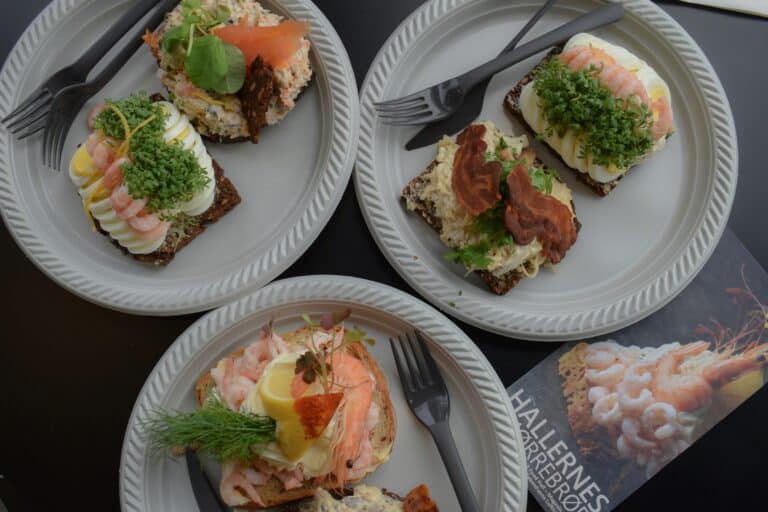Denmark is a Scandinavian country of nearly 6 million people between Germany and Sweden. Located on the Jutland Peninsula and surrounding islands, this nation boasts a flavorful culinary heritage. Due to its geography, Danish cuisine celebrates the land and sea with its long coastline and fertile agricultural lands.
Today, Denmark receives over 7 million annual visitors, many eager to experience the New Nordic Cuisine evolving throughout the country. So, whether you’re planning a Copenhagen food tour or passionate about Scandinavian cooking, Denmark combines familiar and innovative flavors.
Join Remitly as we embark on a journey through Danish gastronomy in our newest food series. From timeless recipes to cutting-edge culinary inventions, this article is your crash course in Danish cuisine.
Most popular Danish dishes
Smørrebrød
Smørrebrød is one of Denmark’s signature foods and culinary contributions to the European food scene. These open-faced sandwiches consist of artfully arranged toppings on hearty rye bread. Originally popularized among factory workers, the name “smørrebrød” literally translates to “butter bread” in Danish, reflecting the dish’s humble origins.
Fast forward and smørrebrøds have become a high culinary art, often enjoyed at lunchtime. Each open sandwich is an intricate creation without any concrete rules for assembly. For both Danes and visitors alike, this is the epitome of Danish cuisine. Common variations include:
- Dyrlægens natmad: liver pâté with salt beef, onions, and aspic on rye bread
- Røget laks: smoked salmon with dill and lemon juice
- Kartoffelmad: sliced potatoes with mayonnaise, chives, and crispy onions
- Roast beef: thinly sliced beef with remoulade, crispy onions, and horseradish
- Æg og rejer: hard-boiled eggs and shrimp with mayonnaise and dill
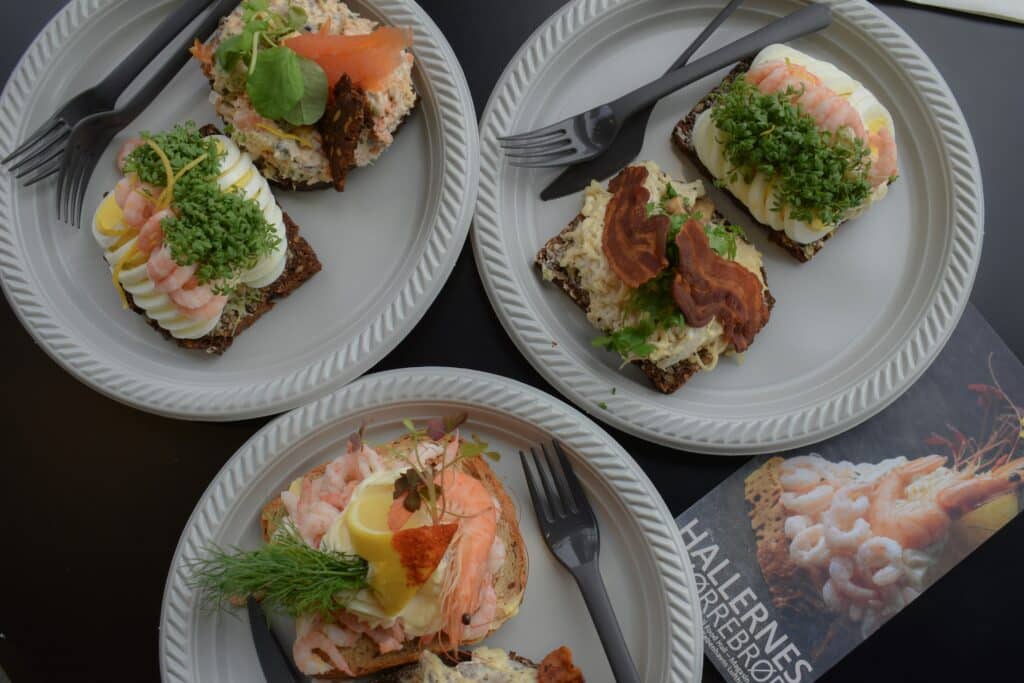
Frikadeller
Frikadeller is a Danish meatball that has a special place in Danish households for its simplicity and adaptability. The name “frikadeller” derives from the Italian word “frittella” meaning fried, which is how the dish is usually prepared.
Suitable for dinners or even quick snacks, these pan-fried meatballs contain ground pork, pork belly, veal, or beef. Traditionally, they are seasoned with onion, eggs, milk or beer, and spices before adding breadcrumbs. Popular variations include:
- Classic frikadeller: served hot with boiled or mashed potatoes, red cabbage, and brown gravy
- Cold frikadeller: enjoyed as part of a smørrebrød or lunch box
- Fiskefrikadeller: cod or salmon fish patties
- Grøntsagsfrikadeller: vegetarian version with vegetables and legumes
- Kyllingefrikadeller: chicken meatballs
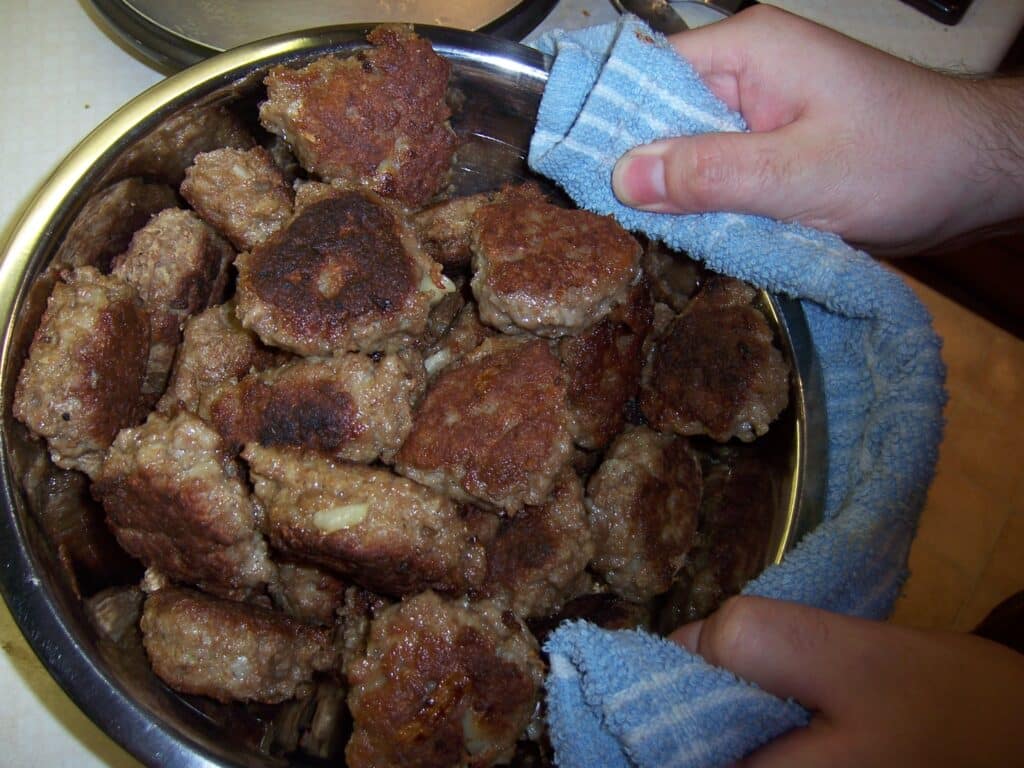
Stegt flæsk med persillesovs
Voted as Denmark’s national dish in 2014, stegt flæsk med persillesovs translates to “fried pork with parsley sauce” in Danish.
Across Denmark, this crispy pork dish with parsley sauce embodies the Danish concept of “hygge,” meaning coziness and comfort. Therefore, it reigns supreme as the country’s go-to comfort food and remains a beloved part of traditional Danish cuisine. Other forms of this classic include:
- Stegt flæsk med brun sovs: served with brown gravy instead of parsley sauce
- Paneret flæsk: breaded pork slices for a little crunch
- Grillet flæsk: grilled instead of pan-fried
Flæskesteg
The Danish name for roast pork is flæskesteg, a cornerstone of the Christmas market season. Linguistically, the name combines “flæsk” (pork) and “steg” (roast), which is an accurate description.
This dish’s defining feature is “svær” (crispy crackling skin), joined by condiments like red cabbage and caramelized potatoes (kartofler). Additional styles to prepare and serve flæskesteg include:
- Juletidsflæskesteg: Christmas version with prunes and apples stuffed in the meat
- Flæskesteg sandwich: thinly sliced on rye bread with cucumber salad and remoulade
- Kold flæskesteg: cold roast pork served as part of a buffet or smørrebrød
- Grillet flæskesteg: grilled version for summer
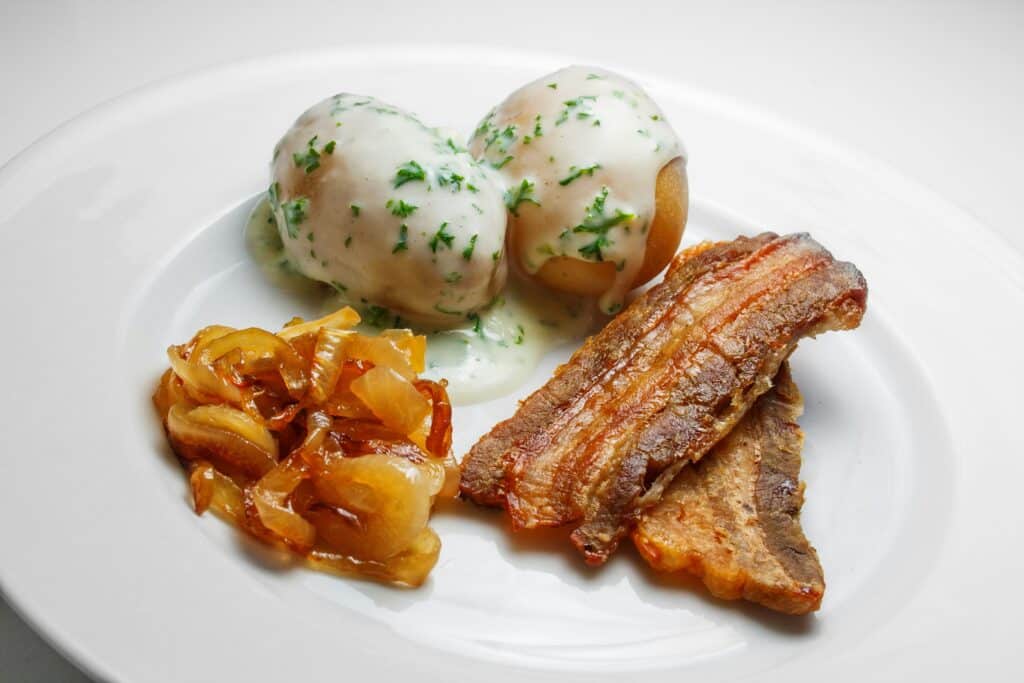
Rugbrød
Rye bread, known as rugbrød, is fundamental to Danish food culture. Both nutritious and flavorful, the dense, dark bread has been a staple in Denmark for centuries.
Beyond smørrebrød, rugbrød is used in traditional dishes like “pebernødder” (pepper nuts) during Christmas and “øllebrød” (bread-based porridge with beer). Varieties of Rugbrød include:
- Fuldkornsrugbrød: whole grain version with cracked rye
- Sigtebrød: a lighter version made with sifted rye flour
- Rugbrødschipper: thin, crispy slices for snacking
- Rugbrødschips: a modern snack of rye bread chips
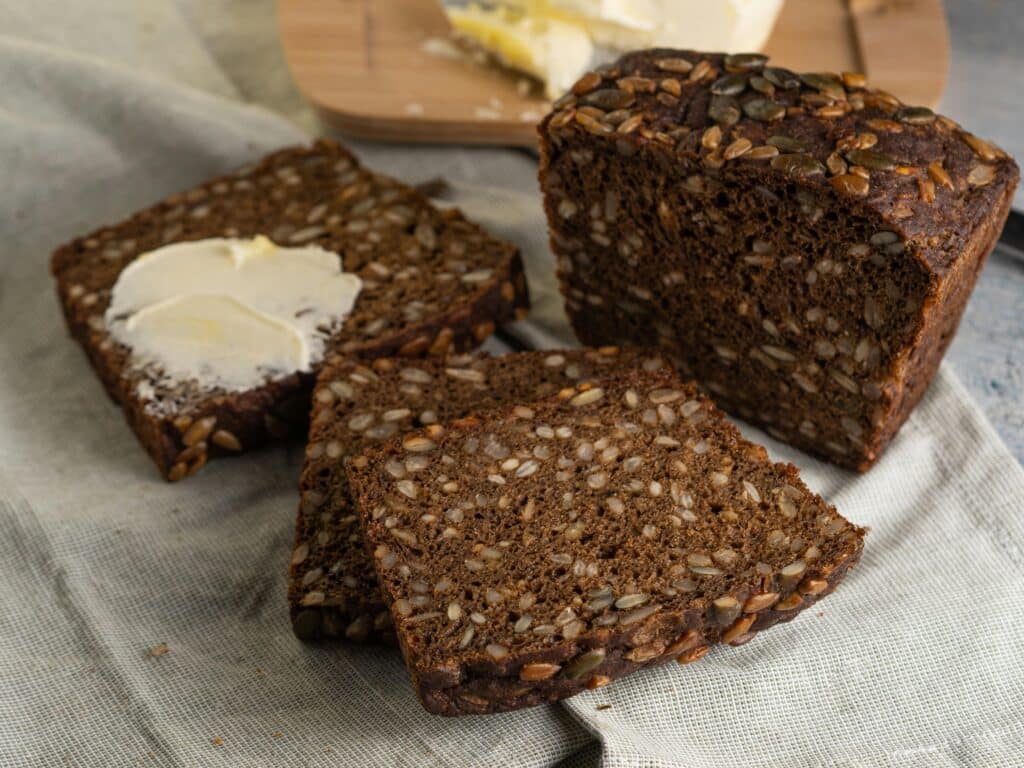
Rye bread is especially put to good use to make delicious smorrebrod, a type of traditional open-faced sandwich that is of great significance for the Danish culture. The sandwich usually consists of a slice of bread topped with butter and various ingredients, mostly fish.
Wienerbrød
Wienerbrøds are Danish pastries that translate to “Viennese pastry braid,” with origins from 19th-century Austrian bakers. As a fusion of Danish baking traditions, they are flaky, buttery, and always satisfying.
In terms of traditional Danish food, these treats are essential for any “kaffepause” (coffee break), not to mention perfectly acceptable for breakfast. In any Danish bakery or supermarket, you should be able to find these different types of wienerbrød:
- Spandauer: a circular pastry with custard or jam filling
- Kanelsnegel: a cinnamon roll-like pastry
- Thebirkes: poppy seed-covered Danish pastry with marzipan filling
- Frøsnapper: a savory version with seeds or cheese

Tarteletter
For beloved appetizers in Denmark, nothing compares to a tarteletter. This crispy bite-size pastry shell comes filled with creamy chicken and asparagus. Inspired by the French word for tart, the delicate pastry is Danish finger food at its finest.
Because of its ingredient versatility, this dish often appears at gatherings or special occasions. Small, light, and fluffy—tarteletters are a guaranteed crowd-pleaser. Certain serving styles include:
- Classic tarteletter: filled with chicken, asparagus, and béchamel sauce
- Seafood tarteletter: shrimp or fish with a dill-infused white sauce
- Vegetarian tarteletter: seasonal vegetables like mushrooms, peas, and carrots in a cream sauce
- Festive tarteletter: lobster or crab filling
Leverpostej
Leverpostej, which translates to liver pâté, holds a special place in Danish cuisine. Found in many Danish households, this savory spread often contains pork liver, lard, onion, milk, and flour.
Of course, leverpostej is a quintessential topping for Danish rye bread. In Denmark and other countries in Scandinavia, liver pâté is an obligatory side piece at every meal. Variants of leverpostej include:
- Classic leverpostej: spread on rye bread with pickled beets and crispy onions
- Bagt leverpostej: oven-baked liver pâté with bacon and mushrooms
- Festive leverpostej: enhanced with truffle or cognac for special occasions
- Leverpostej sandwich: a combination of leverpostej, lettuce, and cucumber on rye bread
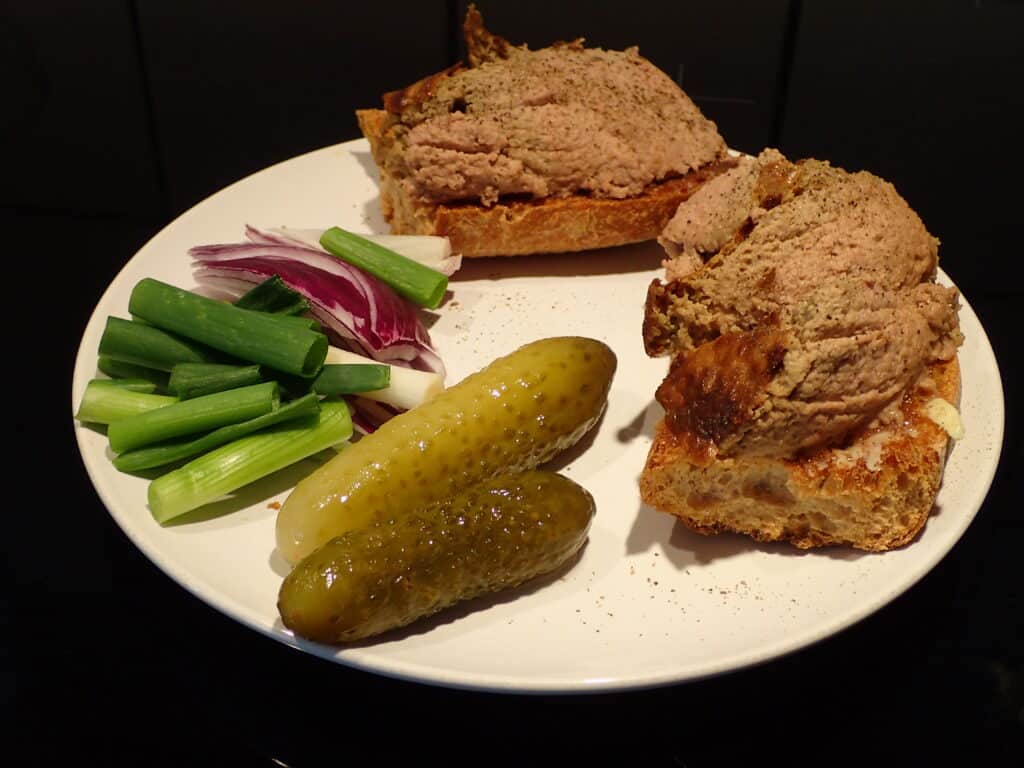
Danish street food: pølser
Hot dogs, known as “pølser,” are Denmark’s top street food. These have a distinct flare compared to the American fast food classic. Unique characteristics of pølsers are longer and thinner sausages, plus served on warm buns. In big cities like Copenhagen, expect to see hot dog stands on many street corners. Variations and toppings include:
- Rød pølse: red sausage served with mustard, ketchup, and remoulade
- Fransk hotdog: sausage stuffed into a hollowed-out baguette with sauces
- Pølsevogn special: topped with crispy onions, pickles, and sweet pickled cucumber
- Ostepølse: an indulgent cheese-filled sausage
Danish pastries and desserts
No Christmas festivity is complete without risalamande in the equation. This classic seasonal dessert is a creamy rice pudding often accompanied by warm cherry sauce on top. Originally, this treat comes from the “riz à l’amande” in France, meaning “rice with almonds.” Differences among this Danish dessert include:
- Traditional risalamande: rice pudding mixed served with whipped cream, vanilla, chopped almonds, and cherry sauce
- Modern risalamande: contemporary flavors like orange zest, cinnamon, or chocolate
- Vegan risalamande: plant-based milk and cream alternatives for dietary preferences
- Berry sauce risalamande: alternative raspberry or blueberry sauces
If you’re craving more sweets, then it’s worth taking a look at karjalanpiirakka, an oval shaped Finnish pastry with rye crust filled with either rice porridge or mashed potatoes.
Christmas food in Denmark
Like other Nordic countries, the Danes adore Christmas and the holiday season. Another common seasonal dessert is æbleskiver, the Danish pancake baked in a special pan with round indentations. Although it translates as “apple slices,” not all interpretations of æbleskiver contain apples. Some of these include:
- Classic æbleskiver: dusted with powdered sugar, served with strawberry or raspberry jams, and occasionally whipped cream
- Stuffed æbleskiver: filled with apple slices, chocolate, or custard
- Savory æbleskiver: a modern twist with cheese and ham filling or herbs and spices
- Gløgg and æbleskiver: traditionally enjoyed with a warm cup of gløgg (spiced mulled wine) during the holiday season
Where can you find Danish food around the world?
Denmark hosts two Michelin-starred restaurants with traditional Danish cuisine. The first is Restaurant Noma, with Danish chefs René Redzepi and Claus Meyer. It was founded in Copenhagen, and previously voted one of the world’s best restaurants. Both chefs have been celebrated in Europe and beyond for their innovative approach to New Nordic Cuisine. Examples of their experimental gastronomic creations include duck-foot candies or “beetles” made from berry hides and black garlic.
The second is Geranium, with Danish chefs Rasmus Kofoed and Søren Ledet. It is a three-starred-Michelin restaurant in Copenhagen. This high-concept establishment inspired by traditional Danish food offers panoramic views of Fælledparken (Common Gardens). A stand-out menu item includes smoked lumpfish roe with kale, apples, marinated mushrooms, and pickled hops.
Outside of Denmark, you can find Danish cuisine in major cities worldwide. New York City is home to several bakeries and restaurants where you can savor classical dishes like smørrebrød and wienerbrød. Smør, Aquavit, and Ole & Steen are some of the best restaurants for traditional Danish dishes in the city.
You can find everything from frikadeller to scrumptious Danish pastries in London. Influences from Scandinavia continue to grow in this metropolitan city with solid options. Two of the top-rated Danish eateries in London include Ekta Nordic Kitchen Bar and Scandinavian Kitchen. Additionally, visitors and Danish expats in Tokyo have restaurants like Lilla Dalarna that offer an authentic Scandinavian dining experience. Danish and Swedish flavors await newcomers at restaurants like Mikkeller, plus treats like æbleskiver and flæskesteg in various Tokyo patisseries.
Celebrating culture
From smørrebrød and frikadeller, exploring Danish cuisine is a cultural journey filled with diverse and inventive flavors. From Michelin-starred restaurants to local food markets, Denmark is a great place for a hearty meal.
FAQs
- What are some must-try traditional Danish dishes?
-
- Standard Danish dishes include smørrebrød (open-faced sandwiches), frikadeller (Danish meatballs), stegt flæsk med persillesovs (fried pork with parsley sauce), flæskesteg (roast pork), rugbrød (rye bread), and wienerbrød (Danish pastries).
- What is smørrebrød?
-
- Denmark’s famous open-faced sandwich is a smørrebrød, usually served on rye bread with different toppings. These include liver pâté, smoked salmon, potatoes, roast beef, eggs, and shrimp.
- What is Denmark’s national dish?
-
- Stegt flæsk med persillesovs is Denmark’s national dish. It consists of fried pork served with parsley sauce, embodying the Danish concept of “hygge,” which means coziness and comfort.
- What is unique about Danish pastries?
-
- Known as wienerbrød, Danish pastries are flaky and buttery, often filled with custard, jam, or marzipan. Varieties include spandauer (custard or jam-filled), kanelsnegel (cinnamon roll), and thebirkes (poppy seed-covered).
- What are some traditional Danish ingredients and staples?
-
- Traditional Danish ingredients include rye bread, buttermilk, potatoes, pork, pickled herring, red cabbage, remoulade, and various seasonal ingredients.
